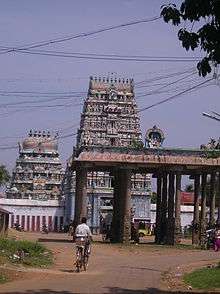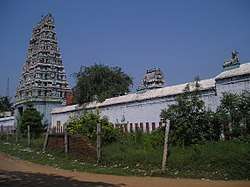Masilamaniswara Temple, Thirumullaivoyal
Masilamaniswara Temple, Thirumullaivoyal or Masilamaniswara Temple is a Hindu temple dedicated to Shiva located in Thirumullaivoyal in the Chennai-Avadi road, India. The temple is incarnated by the hymns of Thevaram and is classified as Paadal Petra Sthalam. The temple is incarnated by the hymns of Sundarar,[1] Ramalinga Swamigal and Arunagirinathar.
| Masilamaniswara Temple | |
|---|---|
 | |
| Religion | |
| Affiliation | Hinduism |
| District | Tiruvallur |
| Deity | Masilamaninathar(Shiva) Kodiyidai Nayagi(Parvati) |
| Features |
|
| Location | |
| Location | Thirumullaivoyal |
| State | Tamil Nadu |
| Country | India |
 Location in Tamil Nadu | |
| Geographic coordinates | 13.136417°N 80.132400°E |
| Architecture | |
| Type | Dravidian architecture |
History
Thirumullaivoyal is one of the many temple towns in the state which is named after the grooves, clusters or forests dominated by a particular variety of a tree or shrub and the same variety of tree or shrub sheltering the presiding deity. The region is believed to have been covered with Chamapaka forest and hence called Chamapakavanam.[2]
In ancient times, the forest surrounding Tirumullaivayil was occupied by two notorious tribesmen, Vaanan and Onan from the Kurumbar tribe. King Thondaiman, the then ruler of the land, wanted to put an end to their atrocities. All his attempts went futile and finally he decided to defeat them in war. He set out for the war with all his infantry and cavalry with elephants and chariots. En route to the war, they waded through a dense growth of Mullai plants (Jasmine climbers). The foot of the elephant on which he was mounted was entangled in the dense foliage. The king and his men, in an attempt to free the elephant from this mess, went on to cut the wild twines with their swords and daggers. Suddenly they noticed blood gushing out from the leaves and found a 'lingam' bleeding. Shocked, the King was in great distress that he has committed a sin.
Seeking mercy and forgiveness from Lord Shiva, he prayed to Him. Without any delay Lord Shiva and Parvathi appeared before the King lest he indulge in causing self-inflicted injury out of grief. The Lord asked the King to build a temple for Him right there and promised that he would reside there as 'Masilamaniswara', the Lord who is as precious as a gem, but without stains ['maasu' - dirty or stain (caused by the profuse bleeding), 'ila' - without, 'mani' - gem]. It is believed that the Lord also promised to support him in destroying the Kurumbars by sending his holy steed, the Nandi bull. On his orders, the Nandi also gets ready to go and fight for the King. This is why the Nandi in this temple faces outwards, ready to leave for the battle on the orders of the Lord, whereas in all other Shiva temples, it faces inwards facing the Lord.
The positions of the deities - Lord Shiva and Goddess Parvathi (Kodiyidai Amman) is also found to be interchanged as against what is usually found in Shiva temples. It is believed to be so because the Lord and His Consort were in a hurry to give 'Darśana' (holy appearance) to the King. With the Lord's blessings and Nandi's support, the King did win over the battle and proceeded to his capital. As a memoir of the victory, he seized a very prized possession of the Kurumbars—two pillars made of the tree trunk of 'Vellerukku' (white Crown flower - Calotropis gigantea). These pillars can be seen even today placed on both sides, decorating the sanctum sanctorum of the Lord.
Architecture
The vimana (roof) of the sanctum sanctorum is designed in a special way that is exclusive to Pallava architecture - the Gaja Prishtam, that looks like the rear of an elephant (Gaja - elephant, prishtam - rear). It is built on a circular base and is known as Thoonganai Maadam in Tamil [thoong(um) - sleeping, aanai - elephant, maadam - top of a building (or temple)] or simply, 'a building that looks like the rear of a sleeping elephant'.
Kodiyidai Nayagi

The Goddess is called Kodiyidai Nayagi - She who has a waist as slender as the Jasmine climber. She is considered to be a very powerful deity and is known to bestow Her gracious blessings for newly weds, unwed girls for speedy marriage and for a happy wedded life.
She and Her counterparts, Tiruvudai Amman Thirumanangeeswarar Temple- She who symbolises Lakshmi and Vadivudai Amman - She who is resplendent with her gracious beauty, are believed to be three Great Goddesses who shower all auspicious things in life if visited and worshipped on the same day of Chitra Pournami - the full moon day in the Tamil month of Chithirai.
- Tiruvudai Amman, Melur: Icha Shakthi
- Vadivudai Amman, Tiruvotriyur: Gnana Shakthi
- Kodiyidai Amman, Tirumullaivayil: Kriya Shakthi
Festivals
Every year in the month of Chittirai(Mar-Apr), on Sadaya nakshatra(Sadayam star), the Santhana kappu is refurbished with Veru kappu. This is believed to be the treatment for the blood that oozed out of the deity because of the king's attack.
References
- History of the Tamils: from the earliest times to 600 A.D. P.26. P. T. Srinivasa Iyengar
- Reddy, G.Venkatramana (2013). Alayam - The Hindu temple - An epitome of Hindu Culture. Mylapore, Chennai: Sri Ramakrishna Math. p. 10. ISBN 978-81-7823-542-4.